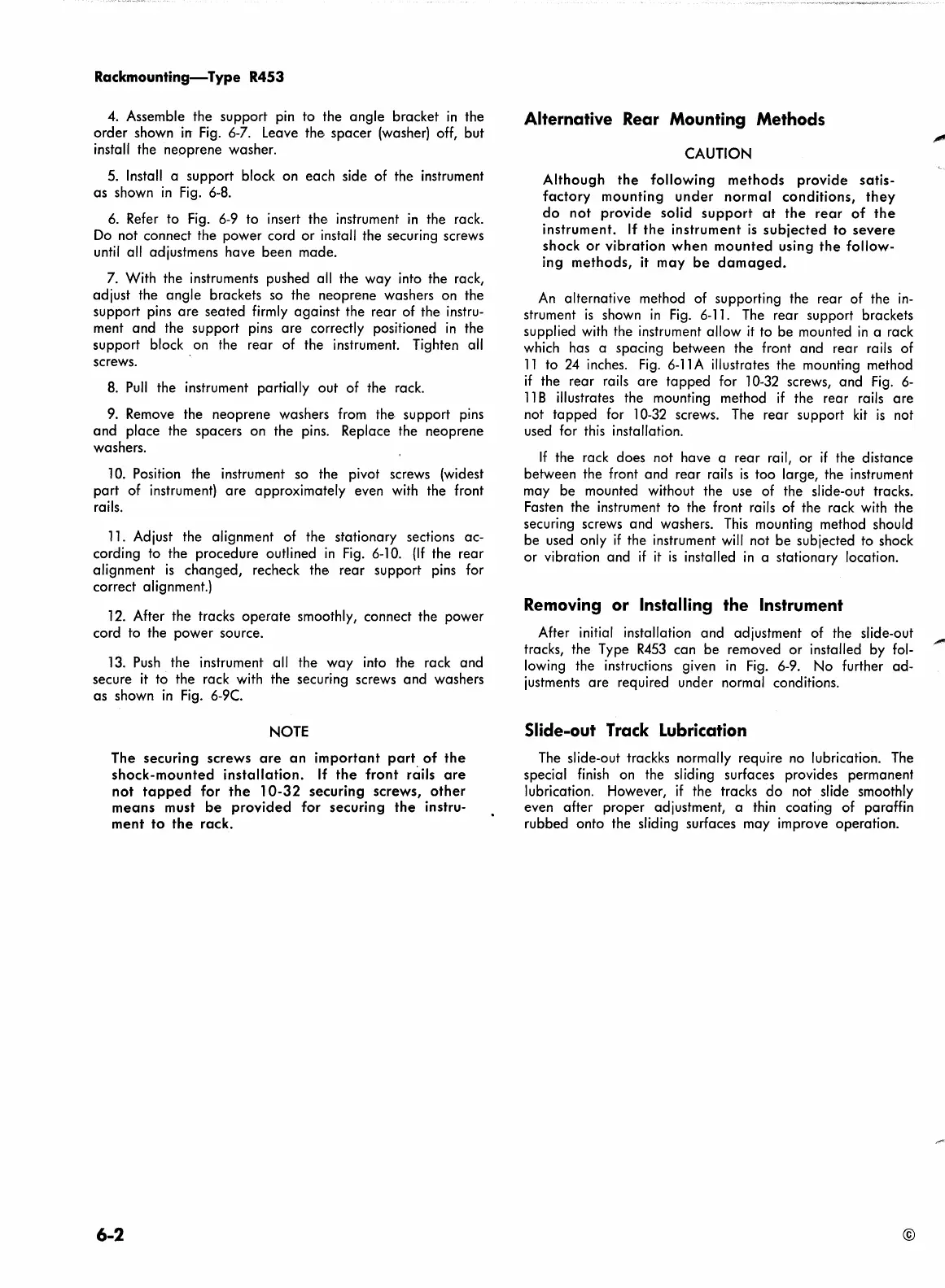Rackmounting-Type R453
4. Assemble
the
support
pin
to
the
angle
bracket
in
the
order
shown
irr
Fig. 6-7. Leave
the
spacer
(washer) off,
but
install the
neoprene
washer.
5. Install a
support
block
on
each
side
of
the instrument
as
shown
in
Fig. 6-8.
6. Refer
to
Fig. 6-9
to
insert the instrument
in
the rack.
Do not
connect
the
power
cord
or
install the securing screws
until all adjustmens
have
been
made.
7. With
the
instruments pushed all
the
way
into the rack,
adjust
the
angle
brackets so the
neoprene
washers
on
the
support
pins
are
seated
firmly
against
the
rear
of the instru-
ment
and
the
support
pins
are
correctly positioned
in
the
support
block .
on
the
rear
of
the instrument. Tighten all
screws.
8.
Pull
the instrument partially
out
of
the
rack.
9. Remove the
neoprene
washers
from
the.
support
pins
and
place
the
spacers
on
the
pins. Replace the
neoprene
washers.
10. Position
the
instrument so
the
pivot screws (widest
part
of
instrument)
are
approximately
even with the front
rails.
11. Adjust the
alignment
of
the
stationary
sections
ac-
cording
to
the
procedure
outlined
in
Fig. 6-10.
(If
the
rear
alignment
is
changed,
recheck
the
rear
support
pins for
correct
alignment.)
12. After
the
tracks
operate
smoothly,
connect
the
power
cord
to
the
power
source.
13. Push the instrument all the
way
into the rack
and
secure it
to
the
rack with the securing screws
and
washers
as
shown
in
Fig. 6-9C.
NOTE
The
securing
screws
are
an
important
part
of
the
shock-mounted
installation.
If
the
front
rails
are
not
tapped
for
the
10-32
securing
screws,
other
means
must
be
provided
for
securing
the
instru-
ment
to
the
rack.
6-2
Alternative Rear Mounting Methods
CAUTION
Although
the
following
methods
provide
satis-
factory
mounting
under
normal
conditions,
they
do
not
provide
solid
support
at
the
rear
of
the
instrument.
If
the
instrument
is
subjected
to
severe
shock
or
vibration
when
mounted
using
the
follow-
ing
methods,
it
may
be
damaged.
An
alternative
method
of
supporting the
rear
of the
in-
strument
is
shown
in
Fig. 6-11. The
rear
support
brackets
supplied with the instrument
allow
it
to
be
mounted
in
a rack
which has a
spacing
between
the front
and
rear
rails of
11
to
24 inches. Fig.
6-11
A illustrates the mounting method
if
the
rear
rails
are
tapped
for 10-32 screws,
and
Fig. 6-
11
B illustrates the mounting method
if
the
rear
rails
are
not
tapped
for 10-32 screws. The
rear
support
kit
is
not
used for this installation.
If the rack
does
not
have
a
rear
rail,
or
if
the
distance
between
the front
and
rear
rails
is
too
large,
the instrument
may
be
mounted without the use
of
the
slide-out tracks.
Fasten the instrument
to
the front rails
of
the rack with the
securing screws
and
washers. This mounting method should
be
used only
if
the instrument will not
be
subjected
to
shock
or
vibration
and
if
it
is
installed
in
a
stationary
location.
Removing or Installing the Instrument
After initial installation
and
adjustment
of
the slide-out
tracks, the Type
R453
can
be
removed
or
installed
by
fol-
lowing the instructions given
in
Fig. 6-9.
No
further
ad-
justments
are
required
under
normal conditions.
Slide-out Track Lubrication
The slide-out trackks normally require no lubrication. The
special finish on the sliding surfaces provides
permanent
lubrication. However,
if
the tracks
do
not slide smoothly
even
after
proper
adjustment, a thin
coating
of
paraffin
rubbed
onto
the sliding surfaces
may
improve
operation.
©

